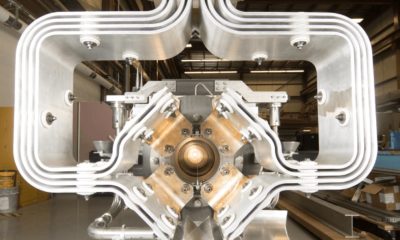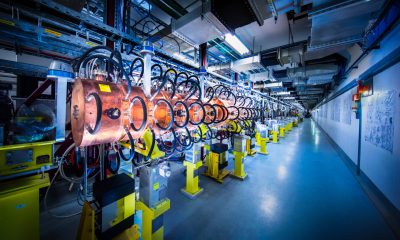Aerospace
KAGRA: Japan’s Cryogenic Gravitational-Wave Detector
Securities.io는 엄격한 편집 기준을 준수하며, 검토된 링크에 대해 보상을 받을 수 있습니다. 당사는 등록된 투자 자문가가 아니며, 이는 투자 자문이 아닙니다. 자세한 내용은 계열사 공개.

How KAGRA Detects Gravitational Waves
The history of astronomy is closely tied to the progress of telescopes, which have progressively revealed more of the Universe to us. It began with the primitive telescope of Galileo and other pioneers, and continues to this day.
As time passes, more and more ways of detecting stellar activity have been deployed beyond the visible light spectrum.
우리는 다음과 같은 새로운 망원경 대형 프로젝트를 여러 개 다루었습니다.
- DKIST세계에서 가장 강력한 태양 망원경.
- 제임스 웹 우주 망원경지구로부터 수백만 마일 떨어진 곳에 위치합니다.
- 베라 C. 루빈 천문대, 하늘 전체를 한꺼번에 관찰하는 조사용 망원경.
- SKAO (Square Kilometre Array Observatory), 전파 스펙트럼으로 하늘을 연구합니다.
- DUNE(심해 중성미자 실험), 포착하기 힘든 중성미자를 감지합니다.
Another new type of astronomy is emerging, one that studies the sky in an entirely novel fashion: instead of light and various wavelengths of electromagnetic waves, it measures gravitational waves.
Only theoretical until relatively recently, now gravitational waves are a proven phenomenon. We previously covered one such “gravity telescope” with the 레이저 간섭계 중력파 관측소 (LIGO).
Another one is the Japanese project Kamioka Gravitational Wave Detector (KAGRA). Taking a different approach from LIGO’s large-scale, multi-site strategy, KAGRA instead focuses on ultra-high precision measurements using cryogenic mirrors to reduce interference.
From Einstein’s Theory to Gravitational Waves
중력은 전자기력이나 원자 수준에서 핵력을 구동하는 힘과 마찬가지로 우주의 기본적인 힘 중 "단지"일 뿐이라고 오랫동안 믿어져 왔습니다.
하지만 20대가 되면서th 19세기에 아인슈타인의 상대성 이론은 중력을 시공간의 곡률로 설명했습니다.
그의 이론은 별과 같은 매우 큰 물체에 중력이 작용하는 방식을 정확하게 설명했을 뿐만 아니라, 중성자별과 블랙홀과 같이 당시에는 발견되지 않은 많은 우주 현상을 예측했습니다.
Another prediction was the existence of gravitational waves, causing space to stretch and squeeze like ripples propagating on the surface of a lake.
Instead, a gravitational wave occurs when the fabric of space-time itself waves or vibrates.
So, gravitational waves are essentially making a specific segment of the universe stretch or contract, making a given distance longer or shorter when they pass by.
Some astronomical events would be likely massive enough to generate gravitational waves strong enough to be measured, like, for example, the collision of two black holes into each other.
However, no matter how powerful such a phenomenon is in absolute terms, the massive distance between Earth and its source, and the difficulty of trying to measure space-time itself, mean that an ultra-sensitive instrument needs to be designed to detect these events.
By the time the gravitational waves reach Earth, millions or billions of light-years away, they are 수천억 몇 배나 더 작습니다.
So you need highly precise measurements, as the amount of space-time wobbling the gravitational waves generated is going to be 10,000x smaller than the nucleus of an atom!
간섭계가 중력파를 감지하는 방법
The first indirect evidence of gravitational waves was obtained through the study of a binary pulsar’s orbit. The orbital decay energy loss matched the predicted energy that would be lost to the generation of gravitational waves, 이 발견을 담당한 과학자들에게 1993년 노벨 물리학상이 수여되었습니다..

출처: 노벨상
직접 측정에는 간섭계를 사용하는 다른 유형의 증명이 필요했습니다. 간섭계의 기본 개념은 빛줄기 사이의 상호작용을 이용하는 것입니다. 두 광파의 파장이 같으면 겹쳐지면서 어둡고 밝은 점의 패턴이 생성됩니다.
But if something changes the distance traveled by these wavelengths, like a gravitational wave, the disturbance can be measured.
중력파로 인한 시공간의 팽창과 수축은 간섭계의 한쪽 팔을 다른 쪽보다 더 크게 팽창하고 수축시키므로, 이로 인해 중력파의 감지 가능하고 측정 가능한 효과가 생성됩니다.
Inside KAGRA: Design and Location
Interferometer Layout (3-km Arms)
Like other interferometers, the base concept of KAGRA is to use a tube several kilometers long, where a laser is fired. That laser beam is then split into two along perpendicular paths.

출처: 노벨상
Both beams are then reflected back after hitting a mirror. Normally, each laser beam should cancel each other out, resulting in no light detected.
하지만 중력파에 의해 한쪽 팔이 다른 쪽보다 더 많이 수축되거나 뻗으면 레이저 빔의 간섭이 멈추고 빛 신호가 감지됩니다.
2015년, 미국 국립과학재단 레이저 간섭계 중력파 관측소(NSF LIGO)는 지구에서 1.3억 광년 떨어진 블랙홀의 충돌로 생성된 파동을 감지했다는 사실을 확인했습니다.
이 획기적인 작업은 물리학자 Rainer Weiss, Barry Barish 및 Kip Thorne은 2017년 노벨 물리학상을 수상했습니다..
What Makes KAGRA Unique (Underground & Cryogenic)
DaVinci에는 LIGO was the first to detect gravitational waves, KAGRA might be the next step in this field of science.
The reason is that KAGRA is built underground, and thanks to an upgrade from its initial setups, when it was still called the Large Scale Cryogenic Gravitational Wave Telescope (LCGT), KAGRA is using test-mass mirrors that are cooled to cryogenic temperatures.
The cold temperature allows for much more precise measurement and will be a key feature of future interferometry projects, like the 아인슈타인 망원경 (launch planned for 2035) or the 우주 탐험가 (launch planned for the 2040s).
KAGRA Technical Specifications
KAGRA is designed to observe gravitational waves from neutron-star binaries out to ~150 Mpc (~489 million light-years), depending on detector sensitivity during a given observing run.
The main body of KAGRA is made of a pair of 3 km-long (1.8 miles) arm tunnels meeting at a 90° angle in the horizontal plane. It is the scaled-up version of the 100-meter-long prototype called Prototype Cryogenic Detector (CLIO).
The installation is located 200 m (656 feet) underground, a design that significantly reduces the noise from seismic waves on the Earth’s surface. Building underground, therefore, solves most of the low-frequency interference impacting surface interferometer designs, like with LIGO.
Despite the region being prone to earthquakes, this specific site is rather shielded, thanks to unique geological features.
“Earthquake waves are weakened when they propagate across the Tateyama mountain range, standing northeast of the KAGRA site.
This is because the low-density ground is distributed at an altitude of approximately 5 km acts as a cushion.”
KAGRA is part of the Kamioka Observatory, located in the Kamioka mine, a laboratory that specializes in the detection of neutrinos, dark matter, and gravitational waves.
The Kamioka Observatory is notable for including 슈퍼카미오칸데, a neutrino detector that made history by detecting the first evidence of neutrino oscillation in 1998.

출처: MDPI
KAGRA was completed on 4 October 2019, after 9 years of construction. Its systems were further upgraded in 2021-2022, after the first observations started in February 2020 were interrupted by the COVID pandemic.
The KAGRA collaboration is composed of more than 360 individuals from more than 90 institutions. KAGRA itself is operated by the University of Tokyo’s Institute for Cosmic Ray Research (ICRR) with contributions from the National Astronomical Observatory of Japan (NAOJ) and the High Energy Accelerator Research Organization (KEK).
스크롤하려면 스와이프하세요 →
| 탐지기 | 팔 길이 | 사이트 | 온도 | 거울 소재 | 주요 차별화 요소 |
|---|---|---|---|---|---|
| KAGRA (Japan) | 3 km | Underground (~200 m) | ~20 K (cryogenic) | Sapphire (~23 kg) | Cryogenic mirrors & reduced seismic noise |
| LIGO (USA) | 4 km (Hanford/Livingston) | 표면 | 방 온도 | Fused silica (~40 kg) | First direct detections; high optical power |
| Virgo (Italy) | 3 km | 표면 | 방 온도 | 용융 실리카 | Advanced seismic isolation (superattenuators) |
| Einstein Telescope (EU, planned) | 10 km (triangular) | 지하에 | 123 K / 10–20 K (dual) | Silicon (planned) | Third-gen sensitivity; dual-band design |
| Cosmic Explorer (US, planned) | ~40 km (concept) | Surface/greenfield | 123 K (concept) | Silicon (concept) | Orders-of-magnitude reach gain |
Vacuum Conditions
The requirement for the laser beams to go without any interference extends to the ambient air, with a strong vacuum and no dust.
The facility follows ISO class 6 cleanroom standards, with ISO 1 cleanroom standards for the laser room and the booths for the cryostats. The walls of the underground facility are coated with anti-dust paint.
An ultra-high vacuum of the order 0.0000007 Pa is achieved through electrochemical buffing.
Meanwhile, the ceilings are covered with plastic sheets to protect the facility from underground water drops.
Laser System & Low-Latency Data
A very powerful and stable laser is needed to work over the 3-kilometer distance and react strongly enough to the gravitational wave.
KAGRA utilizes a 400 mW Nd:YAG NPRO laser, amplified by a commercial fiber amplifier, which yields an output power of 40 W. The laser light within the Fabry-Pérot cavities of the interferometer can reach powers up to a value of 400 kW.
Data are first sent over a 7-km fiber to a nearby analysis building in ~1 second, then to ICRR (Kashiwa) in ~3–10 seconds. Calibrated low-latency data are then shared with the LVK network: typically reaching LIGO sites in ~7–8 seconds and Virgo in ~12–15 seconds.
Cryogenic Mirrors
The mirrors used are made of sapphire, with a diameter and thickness of 22 and 15 cm (9 and 6 inches), and a mass of 23 kg (50 pounds). The high-reflective surface of the mirror is coated with 22-40 layers of silica (SiO₂) and tantala (Ta₂O₅).

출처: 대학원생
The sapphire mirrors are suspended by 35cm-long (14 inches) four sapphire fibers attached with a gallium foil.
This setup allows for the sapphire suspension fiber to transfer 1W of heat from the mirror, which determines the limit of the laser power input before heating interferes with the measurement.

출처: 대학원생
The cryogenic system to cool the mirror uses 99.9999% purity aluminum heat links, each made of a strand of 49 wires, each of 0.15 mm in diameter (6 thousandths of an inch). The mirrors themselves are kept at 20 K (-253 °C / -424 °F).
A series of vibration-absorbing systems keeps the mirror from moving due to the cooling system working.

출처: PTEP
Another vibration-absorbing device protects the mirrors and the laser from seismic vibrations, using an inverted pendulum for horizontal isolation and a geometrical anti-spring filter.

출처: PTEP
독특한 도전
The location and design of KAGRA make it potentially the most powerful gravitational wave detector in the world. It is, however, not without its own set of challenges.
For example, there is an underground spring in the area, which is drained by a pipe at a volume of 1,200 tons of spring water per hour. This creates noise that needs to be neutralized to not interfere with measurements.
Even in a strong vacuum, some molecules of water persist in the air. They tend to form ice at the surface of the mirror due to the ultra-cold conditions. So keeping the cryogenic duct-shields even colder, and regular defrosting are required.
The sapphire mirrors were also not manufactured perfectly, with polarization of the laser light displaying some errors and reducing the efficiency of the entire facility. Further research is ongoing to manage to create a perfectly homogeneous sapphire crystal in terms of birefringence.
The cryo-cooler is also prone to failure, with a lifetime of the rotary valve of only 3000 h, creating a mean time between failures of only 15 days. This was acceptable for early tests, but making longer observations in the future will require this problem to be fixed as well.
KAGRA’s Potential
Due to the upgrade during the pandemic and technical issues still needing fixing, KAGRA has not reached its full potential yet.
It has, however, started to collaborate with LIGO and VIRGO, leading to the detection of more than 200 중력파 이미.
The latest signal, which occurred on March 19, 2025, is over 99% likely to originate from the merger of two black holes.
“The scientific community is intensely engaged in the in-depth analysis of this vast amount of new data that the detectors have provided us over the past year and a half.
We will gather new information about black holes, neutron stars, and the evolution of our Universe.”
These preliminary results already demonstrate that the mergers of two black holes are far more frequent than events involving neutron stars, which are much rarer.
This could, however, maybe be linked to the sensitivity of the detector used, and an upgraded KAGRA might detect more or less powerful interactions between neutron stars.
More accurate measurements will also help detect more distant stellar events or better understand the details of what happens when two black holes collide and merge into each other.
결론
KAGRA is the latest, and likely not the last, of interferometers giving us our first insight into gravitational waves. Not only will these data prove useful for astronomers, but they should open new possibilities for physicists to understand gravity, still the least understood of the four fundamental forces.
A project like this might at first glance appear purely academic. This is rarely the case, even if the direct applications are hard to imagine initially. For example, Einstein’s theory of relativity is today routinely used to calibrate GPS satellites, an everyday application that was difficult to foresee in 1919.
Similarly, KAGRA is pushing scientists to invent ever more precise mirrors, stabilization and cooling systems, and lasers, demanding world-class levels of engineering. These innovations are likely to bear fruit in technologies well beyond astronomy, including advanced computing and space systems.
첨단 광학에 투자
코닝 Incorporated
코닝 Incorporated (GLW -1.3 %)
망원경의 등장으로 첨단 유리의 정밀 제조가 가능해지면서 자동차, 반도체, AI, 방위, 바이오기술, 의료 등 다양한 분야에서 많은 산업적 가능성이 열리고 있습니다. 첨단 광학 시장은 310억 달러 규모로 9.2년까지 연평균 2032% 성장할 것으로 예상됩니다..
코닝은 170년의 역사를 자랑하는 유리 및 광학 기업입니다. 코닝은 창립 이래 토머스 에디슨의 전구에 사용된 최초의 유리 전구, 최초의 저손실 광섬유, 촉매 변환기를 가능하게 하는 셀룰러 기판, 그리고 모바일 기기용 최초의 손상 방지 커버 유리를 생산해 왔습니다.

출처: 코닝
Today, the company is focused on core technologies related to manufacturing glass and ceramics, as well as optical physics technologies, which share common manufacturing processes and end markets.

출처: 코닝
이러한 기술 상호연결을 통해 회사는 다양한 제품 라인 간에 공통적인 제조, 연구 및 엔지니어링 역량을 공유할 수 있습니다. 전 세계 52,000명 이상의 직원, 77개 이상의 제조 시설, 그리고 10개 이상의 R&D 시설을 보유한 이 회사는 해당 틈새 시장에서 큰 영향력을 발휘하고 있습니다.

출처: 코닝
이 회사는 AI와 데이터 센터 구축(광섬유)의 붐과 스크린 및 생명공학 분야에서의 특수 유리 소비 전반의 증가로 이익을 얻고 있습니다.
코닝은 관세의 영향을 크게 받지 않을 것으로 예상됩니다. 미국 매출의 90%가 미국산 제품에서 발생하기 때문입니다. 중국 매출 중 미국 공장에서 발생한 매출은 매우 적으며, 중국 매출의 80%가 중국에서 발생했습니다.
Corning이 전략적 통제를 통해 태양광 패널 시장에 진출함에 따라 관세가 도움이 될 수도 있습니다. 헴록 솔라, to produce US-made panels, as Asian solar panels (not just Chinese) are being submitted to quadruple-digit tariffs. 80% of the capacity has already been secured by customers’ commitments.
태양광 사업은 이 회사에 매우 중요한 사업입니다. 이 회사는 60년 동안 초고순도 실리콘(순도 99.9999999999%)을 포함한 폴리실리콘을 생산해 왔으며, 현재는 미국에서 100% 수입하는 제품인 실리콘 웨이퍼 생산을 시작하고 있습니다. 실리콘은 이 회사의 핵심 제조 전문 지식이며, 이를 처리하는 것이 이 회사에 매우 중요합니다.

출처: 코닝
이 회사는 또한 유리와 세라믹 분야의 전문성을 바탕으로 휘어지는 유리, AR, 탄소 포집 등 다른 첨단 기술에도 관심을 갖고 있습니다.

출처: 코닝
Overall, Corning is a highly technical company with localized manufacturing that should not be affected by deglobalization. It also embraces new markets that match its core competencies, notably solar and optical communication / AI infrastructure. This makes it both a relatively conservative company, only digging deeper into its niche, but also a potential growth stock in high-tech markets.













